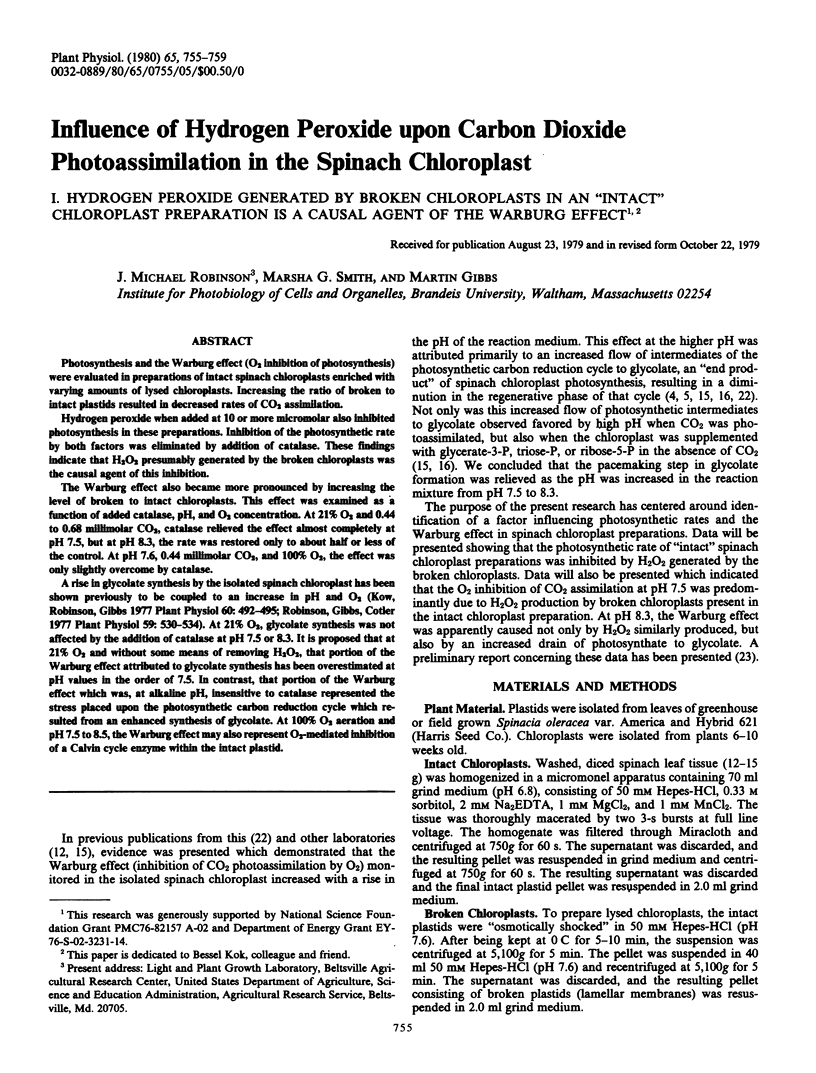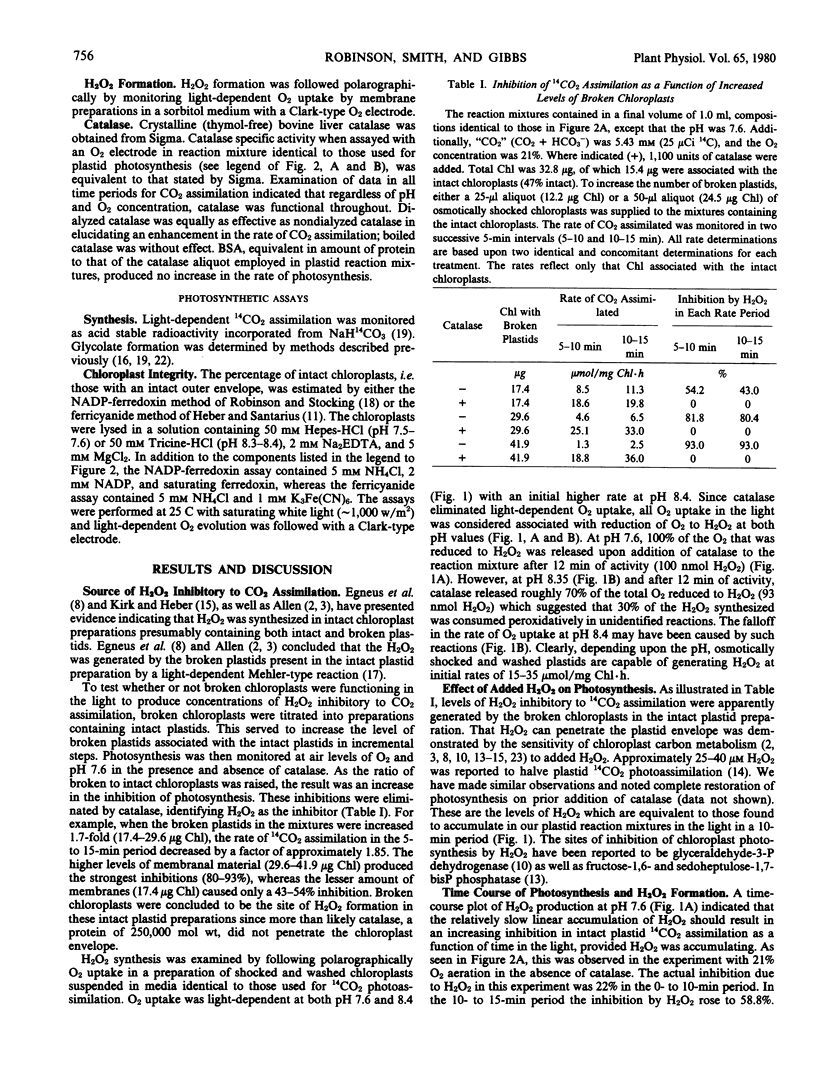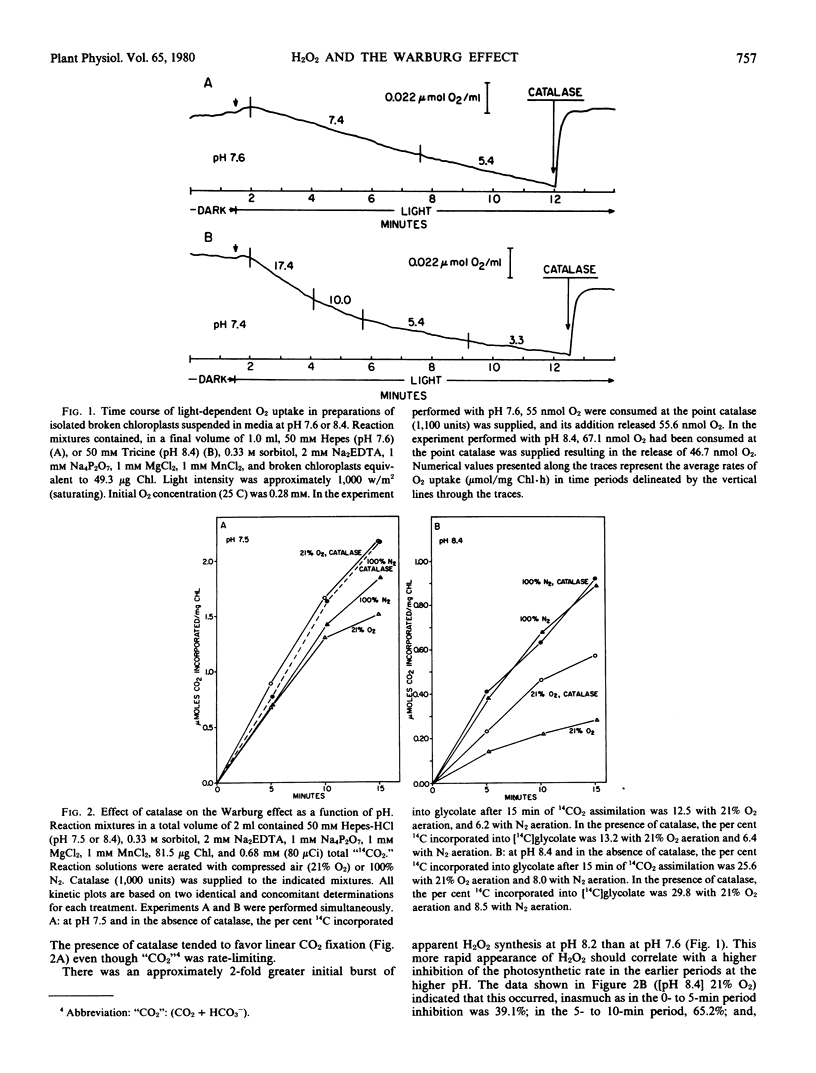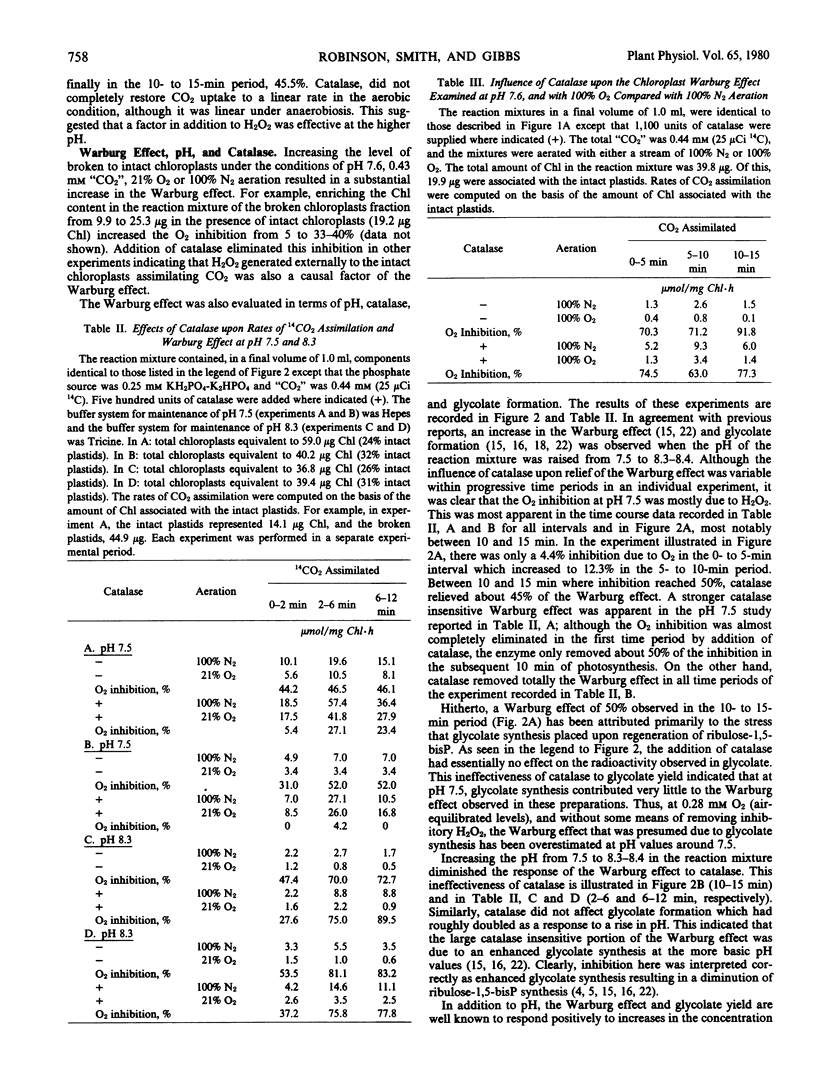Abstract
Photosynthesis and the Warburg effect (O2 inhibition of photosynthesis) were evaluated in preparations of intact spinach chloroplasts enriched with varying amounts of lysed chloroplasts. Increasing the ratio of broken to intact plastids resulted in decreased rates of CO2 assimilation.
Hydrogen peroxide when added at 10 or more micromolar also inhibited photosynthesis in these preparations. Inhibition of the photosynthetic rate by both factors was eliminated by addition of catalase. These findings indicate that H2O2 presumably generated by the broken chloroplasts was the causal agent of this inhibition.
The Warburg effect also became more pronounced by increasing the level of broken to intact chloroplasts. This effect was examined as a function of added catalase, pH, and O2 concentration. At 21% O2 and 0.44 to 0.68 millimolar CO2, catalase relieved the effect almost completely at pH 7.5, but at pH 8.3, the rate was restored only to about half or less of the control. At pH 7.6, 0.44 millimolar CO2, and 100% O2, the effect was only slightly overcome by catalase.
A rise in glycolate synthesis by the isolated spinach chloroplast has been shown previously to be coupled to an increase in pH and O2 (Kow, Robinson, Gibbs 1977 Plant Physiol 60: 492-495; Robinson, Gibbs, Cotler 1977 Plant Physiol 59: 530-534). At 21% O2, glycolate synthesis was not affected by the addition of catalase at pH 7.5 or 8.3. It is proposed that at 21% O2 and without some means of removing H2O2, that portion of the Warburg effect attributed to glycolate synthesis has been overestimated at pH values in the order of 7.5. In contrast, that portion of the Warburg effect which was, at alkaline pH, insensitive to catalase represented the stress placed upon the photosynthetic carbon reduction cycle which resulted from an enhanced synthesis of glycolate. At 100% O2 aeration and pH 7.5 to 8.5, the Warburg effect may also represent O2-mediated inhibition of a Calvin cycle enzyme within the intact plastid.
Full text
PDF




Selected References
These references are in PubMed. This may not be the complete list of references from this article.
- BASSHAM J. A., KIRK M. The effect of oxygen on the reduction of CO2 to glycolic acid and other products during photosynthesis by Chlorella. Biochem Biophys Res Commun. 1962 Nov 27;9:376–380. doi: 10.1016/0006-291x(62)90019-0. [DOI] [PubMed] [Google Scholar]
- Bassham J. A., Kirk M. Sequence of Formation of Phosphoglycolate and Glycolate in Photosynthesizing Chlorella pyrenoidosa. Plant Physiol. 1973 Nov;52(5):407–411. doi: 10.1104/pp.52.5.407. [DOI] [PMC free article] [PubMed] [Google Scholar]
- Brennan T., Frenkel C. Involvement of hydrogen peroxide in the regulation of senescence in pear. Plant Physiol. 1977 Mar;59(3):411–416. doi: 10.1104/pp.59.3.411. [DOI] [PMC free article] [PubMed] [Google Scholar]
- Egneus H., Heber U., Matthiesen U., Kirk M. Reduction of oxygen by the electron transport chain of chloroplasts during assimilation of carbon dioxide. Biochim Biophys Acta. 1975 Dec 11;408(3):252–268. doi: 10.1016/0005-2728(75)90128-0. [DOI] [PubMed] [Google Scholar]
- Forti G., Gerola P. Inhibition of photosynthesis by azide and cyanide and the role of oxygen in photosynthesis. Plant Physiol. 1977 May;59(5):859–862. doi: 10.1104/pp.59.5.859. [DOI] [PMC free article] [PubMed] [Google Scholar]
- Heber U., Andrews T. J., Boardman N. K. Effects of pH and Oxygen on Photosynthetic Reactions of Intact Chloroplasts. Plant Physiol. 1976 Feb;57(2):277–283. doi: 10.1104/pp.57.2.277. [DOI] [PMC free article] [PubMed] [Google Scholar]
- Heber U., Santarius K. A. Direct and indirect transfer of ATP and ADP across the chloroplast envelope. Z Naturforsch B. 1970 Jul;25(7):718–728. doi: 10.1515/znb-1970-0714. [DOI] [PubMed] [Google Scholar]
- Jackson A. O., Larkins B. A. Influence of Ionic Strength, pH, and Chelation of Divalent Metals on Isolation of Polyribosomes from Tobacco Leaves. Plant Physiol. 1976 Jan;57(1):5–10. doi: 10.1104/pp.57.1.5. [DOI] [PMC free article] [PubMed] [Google Scholar]
- Kaiser W. The effect of hydrogen peroxide on CO2 fixation of isolated intact chloroplasts. Biochim Biophys Acta. 1976 Sep 13;440(3):476–482. doi: 10.1016/0005-2728(76)90035-9. [DOI] [PubMed] [Google Scholar]
- Kow Y. W., Robinson J. M., Gibbs M. Influence of pH upon the Warburg Effect in Isolated Intact Spinach Chloroplasts: II. Interdependency of Glycolate Synthesis upon pH and Calvin Cycle Intermediate Concentration in the Absence of Carbon Dioxide Photoassimilation. Plant Physiol. 1977 Oct;60(4):492–495. doi: 10.1104/pp.60.4.492. [DOI] [PMC free article] [PubMed] [Google Scholar]
- MEHLER A. H. Studies on reactions of illuminated chloroplasts. I. Mechanism of the reduction of oxygen and other Hill reagents. Arch Biochem Biophys. 1951 Aug;33(1):65–77. doi: 10.1016/0003-9861(51)90082-3. [DOI] [PubMed] [Google Scholar]
- Robinson J. M., Gibbs M., Cotler D. N. Influence of pH upon the Warburg Effect in Isolated Intact Spinach Chloroplasts: I. Carbon Dioxide Photoassimilation and Glycolate Synthesis. Plant Physiol. 1977 Apr;59(4):530–534. doi: 10.1104/pp.59.4.530. [DOI] [PMC free article] [PubMed] [Google Scholar]
- Robinson J. M., Gibbs M. Photosynthetic intermediates, the warburg effect, and glycolate synthesis in isolated spinach chloroplasts. Plant Physiol. 1974 Jun;53(6):790–797. doi: 10.1104/pp.53.6.790. [DOI] [PMC free article] [PubMed] [Google Scholar]
- Robinson J. M., Stocking C. R. Oxygen evolution and the permeability of the outer envelope of isolated whole chloroplasts. Plant Physiol. 1968 Oct;43(10):1597–1604. doi: 10.1104/pp.43.10.1597. [DOI] [PMC free article] [PubMed] [Google Scholar]
- Steiger H. M., Beck E. Oxygen Concentration in Isolated Chloroplasts during Photosynthesis. Plant Physiol. 1977 Dec;60(6):903–906. doi: 10.1104/pp.60.6.903. [DOI] [PMC free article] [PubMed] [Google Scholar]
- de la Roche A. I. Increase in linolenic Acid is not a prerequisite for development of freezing tolerance in wheat. Plant Physiol. 1979 Jan;63(1):5–8. doi: 10.1104/pp.63.1.5. [DOI] [PMC free article] [PubMed] [Google Scholar]
- de la Roche A. I. Increase in linolenic Acid is not a prerequisite for development of freezing tolerance in wheat. Plant Physiol. 1979 Jan;63(1):5–8. doi: 10.1104/pp.63.1.5. [DOI] [PMC free article] [PubMed] [Google Scholar]


